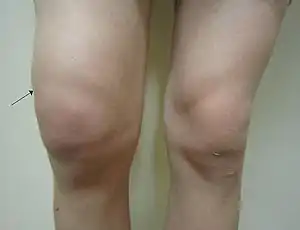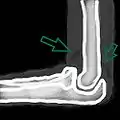Joint effusion
A joint effusion is the presence of increased intra-articular fluid.[1] It may affect any joint. Commonly it involves the knee.
| Joint effusion | |
|---|---|
 | |
| A traumatic right knee effusion. Note the swelling lateral to the kneecap as marked by the arrow. | |
| Specialty | Orthopedics, rheumatology |
Diagnostic approach
The approach to diagnosis depends on the joint involved. While aspiration of the joint is considered the gold standard of treatment, this can be difficult for joints such as the hip. Ultrasound may be used both to verify the existence of an effusion and to guide aspiration.[2]
 Skyline view of the patella demonstrating a large joint effusion as marked by the arrow.
Skyline view of the patella demonstrating a large joint effusion as marked by the arrow. A schematic drawing showing the sail sign which represents an effusion.
A schematic drawing showing the sail sign which represents an effusion.
Differential diagnosis
| Type | WBC per mm3 | % neutrophils | Viscosity | Appearance |
|---|---|---|---|---|
| Normal | <200 | 0 | High | Transparent |
| Osteoarthritis | <5000 | <25 | High | Clear yellow |
| Trauma | <10,000 | <50 | Variable | Bloody |
| Inflammatory | 2,000-50,000 | 50-80 | Low | Cloudy yellow |
| Septic arthritis | >50,000 | >75 | Low | Cloudy yellow |
| Gonorrhea | ~10,000 | 60 | Low | Cloudy yellow |
| Tuberculosis | ~20,000 | 70 | Low | Cloudy yellow |
| Inflammatory = gout, rheumatoid arthritis, rheumatic fever | ||||
There are many causes of joint effusion. It may result from trauma, inflammation, hematologic conditions, or infections.[1]
Septic arthritis
Septic arthritis is the purulent invasion of a joint by an infectious agent[5] with a resultant large effusion due to inflammation.[6]
Gout
Gout is usually present with recurrent attacks of acute inflammatory arthritis (red, tender, hot, swollen joint). It is caused by elevated levels of uric acid in the blood that crystallizes and deposits in joints, tendons, and surrounding tissues. Gout affects 1% of individuals in Western populations at some point in their lives.[7]
Trauma
Trauma from ligamentous, osseous or meniscal injuries can result in an effusion.[8] These are often hemarthrosis or bloody effusions.
Treatment
The treatment for Joint effusion include icing, rest and medication as advised by your Doctor.[9]
References
- Mathison DJ, Teach SJ (November 2009). "Approach to knee effusions". Pediatr Emerg Care. 25 (11): 773–86, quiz 787–8. doi:10.1097/PEC.0b013e3181bec987. PMID 19915432. S2CID 1701019.
- Marx, John (2010). Rosen's emergency medicine: concepts and clinical practice (7th ed.). Philadelphia, PA: Mosby/Elsevier. p. Chapter 53. ISBN 978-0-323-05472-0.
- Flynn, John A.; Choi, Michael J.; Wooster, L. Dwight (2013). Oxford American Handbook of Clinical Medicine. OUP USA. p. 400. ISBN 978-0-19-991494-4.
- Seidman, Aaron J.; Limaiem, Faten (2019), "Synovial Fluid Analysis", StatPearls, StatPearls Publishing, PMID 30725799, retrieved 2019-12-19
- "septic arthritis" at Dorland's Medical Dictionary
- Marx, John (2010). Rosen's emergency medicine: concepts and clinical practice (7th ed.). Philadelphia, PA: Mosby/Elsevier. p. Chapter 134. ISBN 978-0-323-05472-0.
- Chen LX, Schumacher HR (October 2008). "Gout: an evidence-based review". J Clin Rheumatol. 14 (5 Suppl): S55–62. doi:10.1097/RHU.0b013e3181896921. PMID 18830092.
- Johnson MW (April 2000). "Acute knee effusions: a systematic approach to diagnosis". Am Fam Physician. 61 (8): 2391–400. PMID 10794580.
- "A to Z: Joint Effusion". KidsHealth.